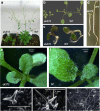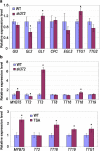COP9 signalosome subunit 5A affects phenylpropanoid metabolism, trichome formation and transcription of key genes of a regulatory tri-protein complex in Arabidopsis
- PMID: 29940863
- PMCID: PMC6020244
- DOI: 10.1186/s12870-018-1347-9
COP9 signalosome subunit 5A affects phenylpropanoid metabolism, trichome formation and transcription of key genes of a regulatory tri-protein complex in Arabidopsis
Abstract
Background: Trichomes and phenylpropanoid-derived phenolics are structural and chemical protection against many adverse conditions. Their production is regulated by a network that includes a TTG1/bHLH/MYB tri-protein complex in Arabidopsis. CSN5a, encoding COP9 signalosome subunit 5a, has also been implicated in trichome and anthocyanin production; however, the regulatory roles of CSN5a in the processes through interaction with the tri-protein complex has yet to be investigated.
Results: In this study, a new csn5a mutant, sk372, was recovered based on its altered morphological and chemical phenotypes compared to wild-type control. Mutant characterization was conducted with an emphasis on trichome and phenylpropanoid production and possible involvement of the tri-protein complex using metabolite and gene transcription profiling and scanning electron microscopy. Seed metabolite analysis revealed that defective CSN5a led to an enhanced production of many compounds in addition to anthocyanin, most notably phenylpropanoids and carotenoids as well as a glycoside of zeatin. Consistent changes in carotenoids and anthocyanin were also found in the sk372 leaves. In addition, 370 genes were differentially expressed in 10-day old seedlings of sk372 compared to its wild type control. Real-time transcript quantitative analysis showed that in sk372, GL2 and tri-protein complex gene TT2 was significantly suppressed (p < 0.05) while complex genes EGL3 and GL3 slightly decreased (p > 0.05). Complex genes MYB75, GL1 and flavonoid biosynthetic genes TT3 and TT18 in sk372 were all significantly enhanced. Overexpression of GL3 driven by cauliflower mosaic virus 35S promotor increased the number of single pointed trichomes only, no other phenotypic recovery in sk372.
Conclusions: Our results indicated clearly that COP9 signalosome subunit CSN5a affects trichome production and the metabolism of a wide range of phenylpropanoid and carotenoid compounds. Enhanced anthocyanin accumulation and reduced trichome production were related to the enhanced MYB75 and suppressed GL2 and some other differentially expressed genes associated with the TTG1/bHLH/MYB complexes.
Keywords: Anthocyanin; Arabidopsis; COP9 signalosome; CSN5a; MYB75; Trichomes.
Conflict of interest statement
Ethics approval and consent to participate
Not applicable.
Consent for publication
Not applicable.
Competing interests
The authors declare that they have no competing interests.
Publisher’s Note
Springer Nature remains neutral with regard to jurisdictional claims in published maps and institutional affiliations.
Figures






Similar articles
-
Genome-Wide Identification of Direct Targets of the TTG1-bHLH-MYB Complex in Regulating Trichome Formation and Flavonoid Accumulation in Arabidopsis Thaliana.Int J Mol Sci. 2019 Oct 10;20(20):5014. doi: 10.3390/ijms20205014. Int J Mol Sci. 2019. PMID: 31658678 Free PMC article.
-
SAD2 in Arabidopsis functions in trichome initiation through mediating GL3 function and regulating GL1, TTG1 and GL2 expression.J Integr Plant Biol. 2008 Jul;50(7):906-17. doi: 10.1111/j.1744-7909.2008.00695.x. J Integr Plant Biol. 2008. PMID: 18713401
-
Arabidopsis JMJ29 is involved in trichome development by regulating the core trichome initiation gene GLABRA3.Plant J. 2020 Aug;103(5):1735-1743. doi: 10.1111/tpj.14858. Epub 2020 Jun 10. Plant J. 2020. PMID: 32445267
-
GLABRA2, A Common Regulator for Epidermal Cell Fate Determination and Anthocyanin Biosynthesis in Arabidopsis.Int J Mol Sci. 2019 Oct 9;20(20):4997. doi: 10.3390/ijms20204997. Int J Mol Sci. 2019. PMID: 31601032 Free PMC article. Review.
-
Updates on molecular mechanisms in the development of branched trichome in Arabidopsis and nonbranched in cotton.Plant Biotechnol J. 2019 Sep;17(9):1706-1722. doi: 10.1111/pbi.13167. Epub 2019 Jun 11. Plant Biotechnol J. 2019. PMID: 31111642 Free PMC article. Review.
Cited by
-
A rhabdovirus accessory protein inhibits jasmonic acid signaling in plants to attract insect vectors.Plant Physiol. 2022 Sep 28;190(2):1349-1364. doi: 10.1093/plphys/kiac319. Plant Physiol. 2022. PMID: 35771641 Free PMC article.
-
Novel loci associated with resistance to downy and powdery mildew in grapevine.Front Plant Sci. 2024 Mar 22;15:1386225. doi: 10.3389/fpls.2024.1386225. eCollection 2024. Front Plant Sci. 2024. PMID: 38584944 Free PMC article.
-
Both Two CtACO3 Transcripts Promoting the Accumulation of the Flavonoid Profiles in Overexpressed Transgenic Safflower.Front Plant Sci. 2022 Apr 6;13:833811. doi: 10.3389/fpls.2022.833811. eCollection 2022. Front Plant Sci. 2022. PMID: 35463446 Free PMC article.
-
Salt responsive alternative splicing of a RING finger E3 ligase modulates the salt stress tolerance by fine-tuning the balance of COP9 signalosome subunit 5A.PLoS Genet. 2021 Nov 16;17(11):e1009898. doi: 10.1371/journal.pgen.1009898. eCollection 2021 Nov. PLoS Genet. 2021. PMID: 34784357 Free PMC article.
-
Inferring functional communities from partially observed biological networks exploiting geometric topology and side information.Sci Rep. 2022 Jun 27;12(1):10883. doi: 10.1038/s41598-022-14631-x. Sci Rep. 2022. PMID: 35760826 Free PMC article.
References
MeSH terms
Substances
Grants and funding
LinkOut - more resources
Full Text Sources
Other Literature Sources
Molecular Biology Databases

